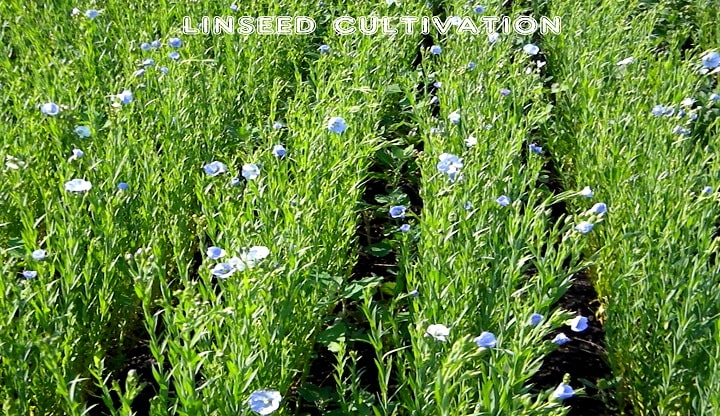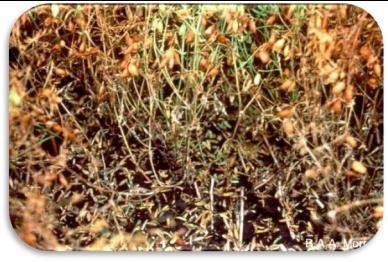


Linseed is an annual herbaceous plant with 30 to 120 cm height. It can be grown very well in rice fallows and productivity can be increased by adoption of improved practices such as, proper cutting height of rice stubbles and tillage practice as well as application of fertilizers are considered important for linseed cultivation in rice fallows.
(Linum usitassimum L.), more commonly known as flaxseed or linseed belongs to the Linaceae family with the genus being Linum containing around 100 species. There are five wild species found in India, namely; L. perenne, L. strictrum, L. mysorense, L.angustifolium and L.grandiflorum.
Major linseed growing States in the country are Madhya Pradesh, Karnataka, Chhattisgarh, Jharkhand, Bihar, Maharashtra, Odisha, Uttar Pradesh, West Bengal and Assam.


The linseed contains 35-45% oil, which contains 9-10% of saturated fatty acids (palmitic and stearic), about 20% monounsaturated fatty acids (mainly oleic acid), and more than 70% alpha-linoleic fatty acids. The protein content in seeds of flax varies from 20-30%. Proteins of flaxseeds are limited by lysine, but are characterized by a high coefficient of digestibility (89.6%) and biological value (77.4%). The content of dietary fiber reaches 28% by weight of whole seed, with the ratio of soluble and insoluble fractions from 20:80 until 40:60. Vitamin E in the flaxseeds is mainly in the form of gamma-tocopherol (9.2 mg/100 g of seeds). Flaxseed is the richest in the vegetable world source of lignans (up to 0.7-1.5% of dry weight of seed). The chemical composition of flaxseed has identified areas in the study of preventive and functional properties. PUFA omega-3 family, dietary fibers and phytoestrogen lignans determine hypo lipidemic and anti atherogenic actions of flaxseed. Flax seeds under the conditions of storage and processing technologies are harmless food product. Consumption of 50 g/day of flaxseed showed no adverse effects in humans.

Linseed is an important rabi oilseed crop occupies an area of 0.07 lakh ha with a productivity of 5.16 q/ha and gaining popularity in recent years.

Linseed is a cool season crop and requires moderate to cool temperature. This crop is under cultivation in three ecosystems namely utera, rainfed and irrigated. Growing linseed in utera system is the predominant practice in Eastern States under paddy fallows.

It is grown best in well drained, fertile, medium and heavy soils especially silty loam, clay loam and silty clays.

| Variety | Year of release | Duration (days) | Yield (kg/ha) | Oil Content (%) | Agro. Zone | Situation/Condition |
|---|---|---|---|---|---|---|
| T-397 | 1984 | 125-130 | 500-600 | 44 | LBVZ, CBVZ & NBPZ | Rainfed/Utera |
| Shekhar | 2001 | 130-135 | 500-600 | 43 | do | Utera |
| Padmini | 1999 | 125-130 | 600-700 | 42 | do | Utera |
| RLC-153 | 2019 | 125-130 | 700 | 44 | do | Utera |

The field is to be ploughed 3-4 times, followed by 1-2 laddering to obtain fine tilth.
| Nutrient | Requirement (kg/ha) | Form | Fertilizer requirement (kg/ha) | Fertilizer requirement (kg/bigha) |
|---|---|---|---|---|
| N | 40 | Urea | 88 | 12 |
| P2O5 | 20 | SSP | 125 | 18 |
| K2O | 10 | MOP | 16 | 2 |
NPK may also be supplied in the form of mixed fertilizers.
CaCO3 in the form of dolomitic Linseed @ 65.5 kg/bigha should be applied 15 days before seeding and incorporated into the soil in areas where multiple cropping is practiced.
Optimum time of sowing is from the middle of October to the middle of November. In Barak Valley Zone, sowing can be done in December after the harvest of sali paddy.
15-20 kg/ha
A spacing of 25 cm between rows and 10 cm between plants should be maintained.
One weeding at 20-25 days after sowing is needed.

Symptoms can occur at both the seedling and plant developmental stage and appears as patches in the field. The root system appears healthy, but with a reduced proliferation and nodulation rate.

For control of wilt disease:

The crop is ready for completely harvest when plants become dry and the leaves fall off.
Jorhat, PIN - 785013 Assam